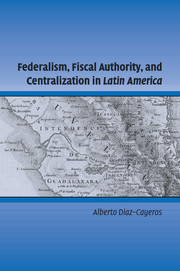Book contents
- Frontmatter
- Contents
- List of Figures
- List of Tables
- Preface
- Federalism, Fiscal Authority, and Centralization in Latin America
- 1 FEDERALISM, PARTY HEGEMONY, AND THE CENTRALIZATION OF FISCAL AUTHORITY
- Part I Fiscal Centralization in Mexico
- Part II Centralization and Revenue-Sharing in the Latin American Federations
- 6 VENEZUELA: UNITARIANISM IN DISGUISE
- 7 ARGENTINA: REGIME CHANGE AND FRAGILE CREDIBILITY
- 8 BRAZIL: THE RETENTION OF FISCAL AUTHORITY
- 9 CONCLUSION: STATE-BUILDING, POLITICAL INSTITUTIONS, AND FISCAL AUTHORITY
- References
- Index
- Titles in the Series
7 - ARGENTINA: REGIME CHANGE AND FRAGILE CREDIBILITY
Published online by Cambridge University Press: 08 January 2010
- Frontmatter
- Contents
- List of Figures
- List of Tables
- Preface
- Federalism, Fiscal Authority, and Centralization in Latin America
- 1 FEDERALISM, PARTY HEGEMONY, AND THE CENTRALIZATION OF FISCAL AUTHORITY
- Part I Fiscal Centralization in Mexico
- Part II Centralization and Revenue-Sharing in the Latin American Federations
- 6 VENEZUELA: UNITARIANISM IN DISGUISE
- 7 ARGENTINA: REGIME CHANGE AND FRAGILE CREDIBILITY
- 8 BRAZIL: THE RETENTION OF FISCAL AUTHORITY
- 9 CONCLUSION: STATE-BUILDING, POLITICAL INSTITUTIONS, AND FISCAL AUTHORITY
- References
- Index
- Titles in the Series
Summary
Coalition Formation in the Midst of Instability
The Argentine federation was formally constituted in 1853, to be joined by Buenos Aires in 1860. It was preceded, after independence, by what Gibson and Falleti (2004) call a “hegemonic confederation.” That confederation, dating to 1831, subdued the interests of the dominant province, Buenos Aires, through the iron-fist rule of Juan Manuel de Rosas. The subsequent “unity by the stick” of Argentine federalism (Gibson and Falleti, 2004) was achieved when provinces joined together in a centralized but asymmetric federation, with Buenos Aires keeping a privileged position. When the federal capital was created in 1853, control over the most important source of taxation, international trade through customs, became federal. The provinces, however, retained more fiscal authority than states in Venezuela or Mexico. To a large extent, the characteristics of the fiscal pact in Argentina are accounted for by the distrust of the “peripheral” interior provinces toward the “core,” represented by the federal government and Buenos Aires.
Fiscal centralization was always feared on the grounds that it would privilege the outward-oriented port city and the beef- and grain-producing Pampas vis-à-vis the regional interests of the “interior.” The political coalition that emerged triumphant in the 20th century involved the urban workers countering the influence of the export-oriented Pampas through the construction of a coalition with the more backward periphery (Gibson, 1996).
- Type
- Chapter
- Information
- Publisher: Cambridge University PressPrint publication year: 2006

